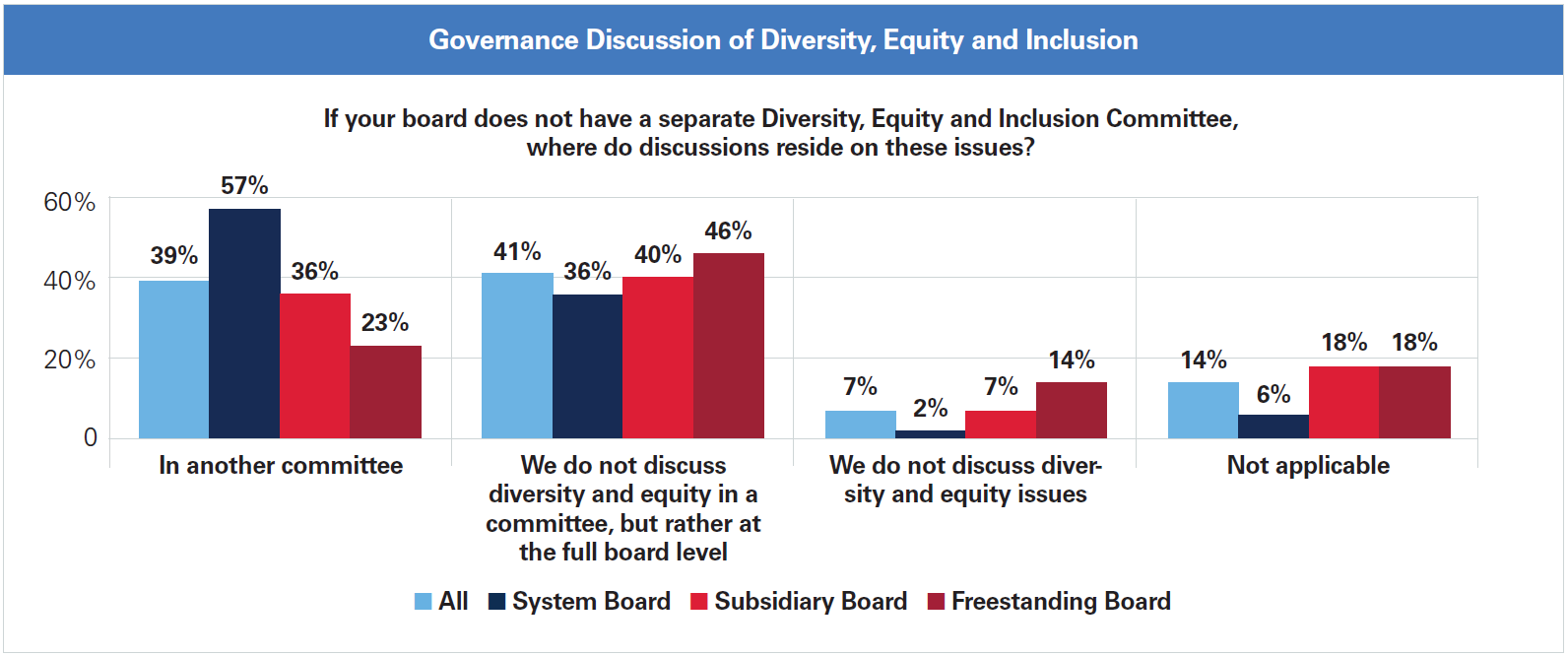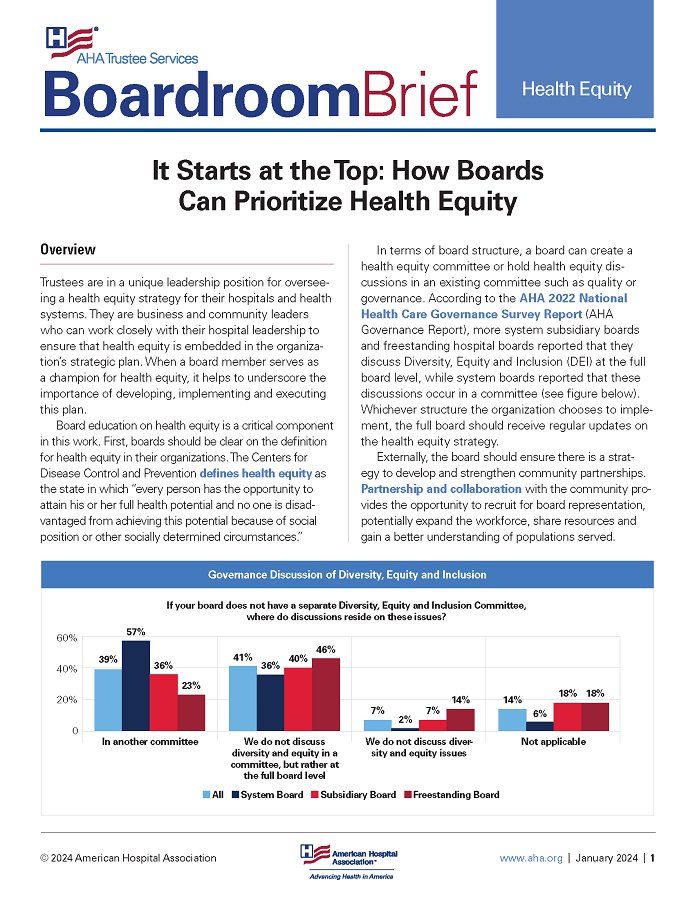Boardroom Brief: It Starts at the Top: How Boards Can Prioritize Health Equity
Health Equity
Overview
Trustees are in a unique leadership position for overseeing a health equity strategy for their hospitals and health systems. They are business and community leaders who can work closely with their hospital leadership to ensure that health equity is embedded in the organization’s strategic plan. When a board member serves as a champion for health equity, it helps to underscore the importance of developing, implementing and executing this plan.
Board education on health equity is a critical component in this work. First, boards should be clear on the definition for health equity in their organizations. The Centers for Disease Control and Prevention defines health equity as the state in which “every person has the opportunity to attain his or her full health potential and no one is disadvantaged from achieving this potential because of social position or other socially determined circumstances.”
In terms of board structure, a board can create a health equity committee or hold health equity discussions in an existing committee such as quality or governance. According to the AHA 2022 National Health Care Governance Survey Report (AHA Governance Report), more system subsidiary boards and freestanding hospital boards reported that they discuss Diversity, Equity and Inclusion (DEI) at the full board level, while system boards reported that these discussions occur in a committee (see figure below). Whichever structure the organization chooses to implement, the full board should receive regular updates on the health equity strategy.
Externally, the board should ensure there is a strategy to develop and strengthen community partnerships. Partnership and collaboration with the community provides the opportunity to recruit for board representation, potentially expand the workforce, share resources and gain a better understanding of populations served.

Through community partnerships, hospital and health system boards can help address disparities and improve access to care and outcomes for the populations their communities serve. For example, some hospitals work with community partners to help provide medical care using mobile vans for patients who are unable to access care easily. Ensuring equitable access to quality care is part of the responsibility of hospital and health system boards to serve their communities.
The Board’s Role in Health Equity
Health equity must be a top priority of hospitals and health systems if quality is to be improved, but how can organizations remain accountable? We know that for health equity work to be prioritized, the board must hold itself and executive leadership accountable. Accountability begins at the top and ideally cascades throughout the organization until it becomes part of the organization’s culture.
The AHA Governance Report highlighted important findings regarding boards and diversity. Boards must continue to diversify their composition. Board diversity is a great way to bring previously unheard voices to the table. Trustee Services spoke with three distinguished board leaders about their experience in diversifying their boards. This discussion focused on the board’s ability to distinctly define their desired makeup when it comes to composition, as well as making the diversity criteria explicit when working with search firms on recruitment strategy.
The AHA’s Institute for Diversity and Health Equity (IFDHE) developed a Health Equity Roadmap which provides a tool for self-assessment and information about a hospital’s placement on its health equity journey. Boards can look to The Six Levers of Transformation, including the Lever for Diverse Representation in Leadership and Governance, to see examples of how this change can be implemented. Many organizations have completed the Health Equity Transformation Assessment (HETA), the first step a hospital can take to better understand the opportunities for transformation. Trustees can make sure leaders understand how important equity work is to their organization and encourage their organization to complete the HETA as a way to assess their progress.
Resiliency
Organizations must remain resilient in times of constant change to provide continued, equitable care for the populations they serve. Boards cannot be resilient without connecting with and listening to their communities. They also must make sure that health equity is embedded in the operation of their organizations, leading to sustainable and equitable outcomes.
Making the Business Case for Health Equity
Rising costs have placed financial constraints on hospitals and health systems. “When health care providers cannot afford the tools and teams they need to care for patients, they will be forced to make hard choices and the people who will be impacted the most are patients,” writes American Hospital Association President and CEO, Rick Pollack. This is especially true for hospitals in areas of great inequity.
Racial inequities are associated with substantial annual economic losses nationally. A national study conducted by the W.K. Kellogg Foundation and Altarum noted that health disparities contribute to an annual economic loss of $42 billion in untapped productivity, $93 billion in excess medical care expenditures and $175 billion in premature deaths. Furthermore, by 2050, the United States stands to gain $8 trillion in gross domestic product by closing our racial equity gap. These losses are primarily a result of the disparities in health, education, employment and other socioeconomic factors that disproportionately affect racial and ethnic minority groups. While the return on investment for health equity efforts is long term and often in the form of cost avoidance, boards should ensure their organizations’ efforts are sustained.
As the U.S. population becomes increasingly diverse, addressing health inequities will be even more crucial, and economic losses related to health inequities are likely to rise.
Organizations have become increasingly aware of how socioeconomic factors affect the patients they treat. As part of their health equity strategy, boards should confirm their hospital and health system is planning for not only their current community needs, but for future needs as well. Health equity is a long-term investment in the hospital and its community. Improving population health and reducing health disparities can lead to more stable and healthier communities.
Trustee Questions for Discussion of Your Organization’s Health Equity Efforts
- Is health equity part of your board and organization strategy?
- Does your board have a board education strategy on health equity, diversity and inclusion?
- How can your board benefit from diversifying its composition?
- How could your board restructure current meeting practices and service requirements to make serving on your board more attractive to diverse candidates?
- What are the roadblocks to pursuing health equity?
- Do trustees understand the business case for health equity as it pertains to your organization?
- What community partnerships can the organization leverage to have a more inclusive and equitable relationship with the community?
- Has your executive leadership engaged with the AHA’s Health Equity Transformation Assessment? Is your board using the Board and Leadership lever to assist in developing and enhancing your health equity strategy?
- What are your board’s quantifiable goals to diversify its membership while ensuring proper representation from historically marginalized groups?
- Has your full board had at least one conversation about your organization’s work on DEI?
AHA Resources
- Health Equity, Diversity and Inclusion
- AHA Health Equity Roadmap
- Crosswalk of AHA Health Equity Roadmap with Selected National Health Equity Quality Measures and Standards for Hospitals and Health Systems
- AHA 2022 National Health Care Governance Survey Report
- Health Equity Action Library
- Podcasts on Diversity and the Future of Boards
- Diverse Board Members Offer Their Perspectives
- Health Equity Crosses All Board Responsibilities
- How You Can Advance Your Board Diversity Strategies

